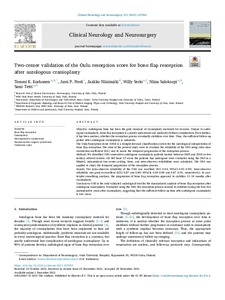Two-center validation of the Oulu resorption score for bone flap resorption after autologous cranioplasty
Posti Jussi P; Niinimäki Jaakko; Serlo Willy; Korhonen Tommi K; Salokorpi Niina; Tetri Sami
https://urn.fi/URN:NBN:fi-fe2022081154051
Tiivistelmä
OBJECTIVE
Autologous bone has been the gold standard of cranioplasty materials for decades. Unique to autologous cranioplasty, bone flap resorption is a poorly understood and unclearly defined complication. Even further, it has been unclear, whether the resorption process eventually stabilizes over time. Thus, the sufficient follow-up period after autologous cranioplasty is unknown.
The Oulu Resorption Score (ORS) is a straight-forward classification system for the radiological interpretation of bone flap resorption. The aims of the present study were to evaluate the reliability of the ORS using intra-class correlation coefficient (ICC) and to assess the temporal progression of the resorption process.
METHODS
We identified 108 consecutive autologous cranioplasty patients treated between 2005 and 2018 in two tertiary referral centers. All 365 head CT scans the patients had undergone were evaluated using the ORS in a blinded, independent two-center setting. Intra- and inter-observer reliabilities were calculated. The ORS was applied to study the temporal progression of the resorption process.
RESULTS
The intra-observer reliability of the ORS was excellent (ICC 0.94, 95%CI 0.93-0.95). Inter-observer reliability was good-to-excellent (ICCs 0.87 and 0.89, 95%CIs 0.84-0.89 and 0.87-0.91, respectively). In scatterplot smoothing analyses, the progression of bone flap resorption appeared to stabilize 12-24 months after cranioplasty.
CONCLUSIONS
ORS is the only validated radiological tool for the standardized analysis of bone flap resorption after autologous cranioplasty. Evaluated using the ORS, the resorption process seemed to stabilize during the first two postoperative years after cranioplasty, suggesting that the sufficient follow-up time after autologous cranioplasty is two years.
Kokoelmat
- Rinnakkaistallenteet [19250]
